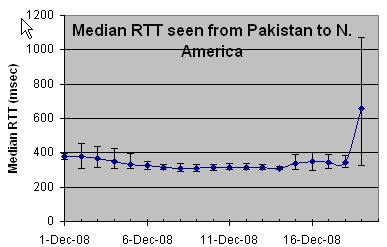...
The measured effects on the losses seen from N. America (SLAC in California) to hosts in N. Africa (Egypt, Sudan); Middle East (Bahrein, Palestine, UAE, Oman, Jordan, Lebanon, Saudia Arabia); S. Asia (Sri Lanka, Maldives, Pakistan) are huge. As seen from PingER daily loss data measured from SLAC, comparing the losses on Friday Dec 19 with those on Mon-Thu (15-18 Dec) the losses have increased by a factor of 5 to 30 times for most of the hosts monitored in the above countries.
Unreachability
Unreachability is defined in PingER terms as when none of the 10 pings sent each 30 mins gets a response. Looking at the PingER data despite the magnitude of these cuts and the large impact on losses there is no indication of unrteachability (100%) losses to any of the hosts measured in the affected regions. This does not mean that applications that require higher bandwidth than pings (1000bits/sec for a short period (~10secs) ), low loss or jitter or Round Trip Time (RTT) will not be badly impacgfed causing them to fail or to be effectively useless. On the other hand it does show that Internet connectivity was successfully maintained due to the use of redundant paths etc.
Round Trip Time (RTT)
An example of the increase in RTT can be seen below in the plot of RTT seen from SLAC to a node in Egypt. The sudden change in RTT from ~ 244ms to almost 400ms can be seen around 9-10am on Friday Dec 19th 2009.
Another view of the effect of the RTT increases is seen in the plot below of the median RTTs measured (thed error bars are the 25% and 75%-tiles) from 3 monitoring hosts in Pakistan (NUST, COMSATS and NCP) to FNAL and SLAC (i.e. 6 pairs of monitor/remote hosts) for the first 19 days of December 2008.
...

